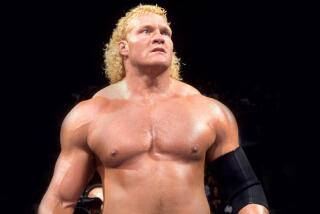Lou Thesz, 86; Former World Champion Wrestler
- Share via
“What you see on TV today is not ... wrestling. That is choreographed tumbling. That is not wrestling. It’s not even related to wrestling.”
--Lou Thesz
*
Lou Thesz, a professional wrestler who actually wrestled and was a champion at it for more than three decades, has died. He was 86.
Thesz died April 28 in Winter Park, Fla., of complications from open heart surgery.
Professional wrestling in the late 1940s and ‘50s was a big draw and became a staple of early television. There was a good bit of show business in the sport--the horror movie star Bela Lugosi, a fellow Hungarian, was once a celebrity corner man for Thesz--and many of the wrestlers wore gorgeous, or gaudy, robes and monocles, had flowing hair and created stage personas that emulated European nobility.
But not Thesz, described in a Times article in 1952 as “a rarity in the ranks” and the “prophet of straight wrestling.”
“He doesn’t braid his hair, throw arsenic to the customers, grind his teeth on a buzz saw, train on celery stalks and tear gas, or wear purple trunks scalloped with dollar signs,” the article stated.
A rock-solid 6 feet, 2 inches and 220 pounds, Thesz stayed in spectacular shape well into his 70s through a regimen of weightlifting, swimming and skiing. In a 55-year career, he held the world-champion title six different times.
Many of the wrestlers of Thesz’s heyday had backgrounds as amateurs and knew how to execute basic moves and holds. Thesz became a master of “hooks,” a collection of submissive holds that could temporarily cripple his opponent.
“Hookers in wrestling means we inflicted pain,” he told the Seattle Times some years ago. “We could twist arms and wrists enough to break them. When I was learning to wrestle, my trainer told me that if I didn’t hurt my opponent, they wouldn’t remember my name.”
The arm twisting and leg bending would send opponents to the mat, where Thesz would pin them. Matches were usually the best-of-three falls for a win.
“When Lou Thesz wrestled in the ‘40s, you needed to know how to wrestle, and you needed enough charisma to draw crowds. Lou had both,” said Mike Chapman, the executive director of the International Wrestling Institute and Museum in Newton, Iowa.
In major cities across the country, top attractions such as Thesz would draw as many as 10,000 fans for an event. At the height of his career, Thesz would be in 200 to 250 matches a year.
According to press accounts at the time, Thesz was one of the top-paid athletes in the early 1950s, making as much as $250,000 a year.
One of his biggest matches came in Los Angeles in May 1952, when he was pitted against Baron Michele Leone of Venice Beach for the World Heavyweight Title.
The event, at an outdoor venue called Gilmore Field at Fairfax Avenue and Beverly Boulevard, drew 25,000 spectators, turned away thousands more and grossed $103,000.
Thesz took the match in two out of three falls and was the toast of the town.
Over the next three decades, Thesz made a steady living on the mat. He was a favorite in Japan, making 30 trips there over the years to compete and to teach wrestling.
Born Aloysius Martin Lou Thesz, he grew up in St. Louis and learned Greco-Roman wrestling from his father, who was an amateur champion in his native Hungary.
Thesz dropped out of school at 14 to work in his father’s shoe shop and to concentrate on wrestling. At 16, he made his debut in East St. Louis, Ill. He lost the match, but within two years he competed for the Midwest Wrestling Assn. world crown, defeating Everett Marshall.
Thesz’s last match took place in Japan in 1990. He was 74 and weighed 215 pounds. His opponent was 27 and weighed 260. Thesz lost the match when his artificial hip buckled.
“I was old enough to know not to do it,” Thesz told the Virginian-Pilot newspaper, “but I did it anyway.”
More to Read
Go beyond the scoreboard
Get the latest on L.A.'s teams in the daily Sports Report newsletter.
You may occasionally receive promotional content from the Los Angeles Times.










